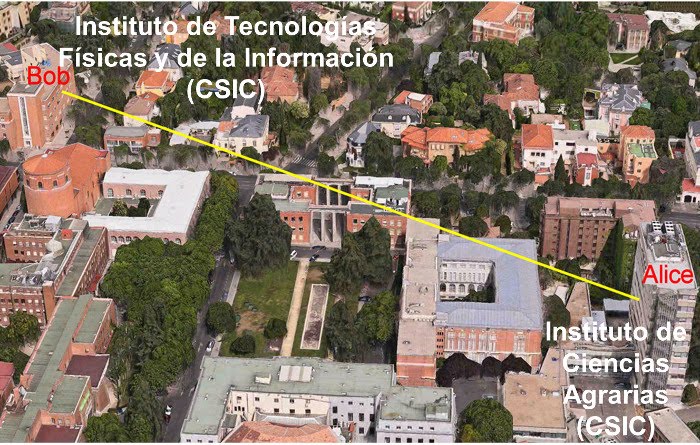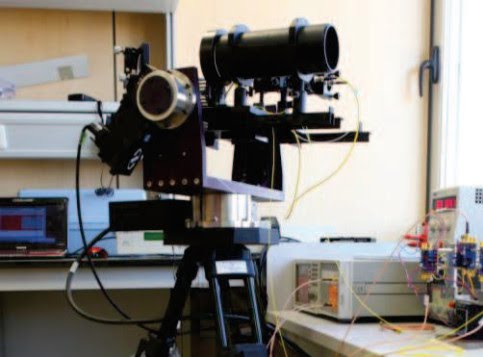 After finishing her degree in Physics in Seville, Verónica Fernández Mármol moved to the UK to do a PhD in experimental QKD at Heriot-Watt University. The topic of her thesis was key distribution using photons that propagate through optical fibers, working in increasing the efficiency and speed at which the random keys are generated. In 2007, Verónica returned to Spain, starting a group on experimental QKD but now working with the goal of achieving key distribution through free space, starting with the metropolitan area of Madrid. Veronica’s experiments on quantum cryptography span now a distance of 300 meters, from the Institute of Physical and Information Technologies (CSIC) to a tall building on the neighbouring CSIC campus around the Students Residence in Madrid. In a recent work, her group has demonstrated a high efficiency device, capable of creating private keys at a rate of 1 megabit per second. These are promising results which demonstrate the potential of free space quantum cryptography, and which offers an alternative route to the commercially viable approaches that are pursued by various companies throughout the world (ID Quantique, MagicQ, SeQurenet, …)
 Sketch of the free space quantum cryptography link between Veronica Fernandez’s lab (ITEFI) and the emitter node (ICA), separated 300m.
Before entering into the details of your research, could you perhaps explain how and why you entered the field of quantum key distribution? I was interested in the fields of photonics and optics since I did my degree in Physics but I had little knowledge of Quantum Information specifically. However, as soon as I visited the lab where I later did my PhD in, at Heriot Watt University, I was impressed: finding experimental applications of theoretical principles of fundamental physics such as the Heisenberg Uncertainty Principle was extremely interesting. Fortunately I could attend some lectures from postgraduate courses that were given in Heriot-Watt University and it helped me improve my background in the field. Finding a PhD was relatively easy. I just contacted my professor via email, which I got from the University website and he got in touch with me. The demand for postgraduate students in UK is high. My PhD was funded through The Engineering and Physical Sciences Research Council (EPSRC) which is a public organism from the UK specialized in funding research in physical and engineering areas. How was the experience of doing a PhD in a foreign university? Did it involve a cultural shock? Did you profit from it in some way? Or has the foreign PhD complicated your life bureaucracy-wise afterwards? It was a very enriching experience, both from a professional and a personal point of view. Of course, there are cultural differences and it takes some time to adapt but Scotland is a very welcoming country and the level of the research carried out there is very high so I was tremendously lucky to have been given the opportunity to work there. Paper wise, it took me so much time validating my PhD thesis from a Spanish University when I came back, but other than that I didn’t have any problems. Your work at Heriot Watt University was centered on improving the efficiency of key distribution in optical fibers. What is the present status of this technology? Does it have enough viability to be of commercial interest? We investigated the approach of using a shorter wavelength, 850 nanometers, for the photon source of a QKD fibre-based system (instead of 1550 nanometers, more commonly employed in fibre-based QKD systems). This wavelength can be efficiently detected by silicon single-photon detectors, which enabled higher rates of operation compared to other single-photon detectors (InGaAs/InP), typically used for detecting 1550 nanometers. Of course a shorter wavelength like 850 nanometers incurs in more losses as it travels through standard telecommunication fiber in the transmission channel but despite this for shorter ranges (20 kilometers) enabled orders of magnitude higher secure key rates than systems working with 1550 nanometers and InGaAs/InP detectors. A few years later, InGaAs/InP detectors were dramatically improved and this approach of using a shorter wavelength is not necessary anymore. In 2007 you return to Spain to work on free space quantum key distribution. What does “free space” mean in this context? Free space means that the stream of photons that travels from Alice to Bob is not guided by physical means, such as optical fibre, but instead travels ‘freely’ through air. Why “free space”? What are the advantages of not using optical fibres? There are several advantages of using free space: the first is its strategic role in enabling global quantum communications, which, in a scenario where the practical use of quantum repeaters is, presumably, still far in the horizon, is the only means of leapfrogging the distance limitation imposed by absorption in optical fibres. Another important advantage is its role in metropolitan networks, where the key advantage of free space links is the installation flexibility they offer due to their portability: they can be relocated in different places according to the needs of the network. The ease and speed of installation is also important, especially in scenarios of natural catastrophes or military conflicts, for example, where the installation of optical fibre might be damaged or impaired. It can also be used as a means to increase the bandwidth of specific points in the network affected by poor connectivity. And what about the new challenges introduced by free space quantum communication? What are the problems solved by your research? Secure key rates of quantum communication remains low. We have worked in trying to improve this for free-space QKD links in urban areas. The main challenges to achieve this are: an emitter and receiver capable of operating at very high speeds. In our case the emitter operates at clock frequencies of GHz, for which timing jitters of all electronic equipment must be kept extremely low (a few picoseconds). At the same time filtering solar radiation off your detectors is another challenge, especially in daylight, since the background light from the sun is coupled into the detectors increasing the error. Nevertheless, we achieved secret key rates higher than similar systems. However, improving the stability of the link by beam tracking techniques can increase key rates even more and this is the line we are investigating now: strategies to compensate for atmospheric turbulent effects. Can you explain a bit how your QKD device works? It consists of two modules: a transmitter and a receiver. The transmitter uses three lasers: two for the quantum signal and a third for a reference clock that serves for timing synchronization of both stations. The three lasers are directed to two lenses that expand and collimate the beam to be sent to the receiver. The receiver is composed of a Schmidt-Cassegrain telescope with the QKD receiver attached. The received events are measured with a high precision electronic card attached to a PC and are used to analyze the quantum bit error rate of the transmission and thus its security.   Receiver and emitter for the free space QKD scheme developed by Veronica’s group.
Various groups in Europe and China are pursuing quantum communication using ground-to-satellite links. Could you tell us a bit about this effort and how this relates to your research?
Using satellites as relay stations can solve the distance-limitation problem that quantum communications faces. China did some very important experimental tests like launching a bright stream of photons to an orbiting satellite and measuring the reflected (single photon) signal back to earth, simulating a satellite sending a single-photon stream to ground. They are also planning on launching a spacecraft in 2016, called the Chinese Quantum Science Satellite, specifically designed to test these concepts. This year, European researchers from the University of Padova have managed to recover the information of polarization-encoded photons after being sent and reflected from different orbiting satellites and demonstrated that the quantum bit error rate can be kept low enough to perform quantum communications. This is crucial for the future of quantum satellite communications. So progress in the field is continuous. Our work is more focused on shorter-links applications for metropolitan networks, and improving its speed. There seem to be two major approaches to the distribution of quantum keys. One method is the BB84 protocol which sends individual photons with random polarization from one device to another. The other alternative is to generate a pair of entangled photons and send them to the two parties which want to generate the key. In both cases, the random orientation of the photon polarization and of the measurement basis ensures secrecy and security. What are the advantadges of each method? Which one do you or your colleagues use? There are two main QKD schemes: the prepare-and-measure protocols which use mainly polarized photons (WCP) and entanglement-based QKD, which uses entangled photons. The first is based on quantum uncertainty whereas the second is on quantum entanglement. Each has different advantages and disadvantages. For example entanglement based QKD can in principle tolerate more losses (up to 70dB) than WCP-based protocols, although technologically speaking the process of efficiently generating entangled pairs can be more challenging. We use the first approximation.
What is the position of Spain in the fields of quantum communication and quantum cryptography? Do you feel that experimental quantum information is sufficiently represented in our country, or how could this be improved?
There are excellent theoretical and experimental groups dedicated to quantum information technologies in Spain, but comparatively-speaking, our critical mass is still below countries like United Kingdom, France or Germany. I think quantum technologies is already a key field that is taking a major role in fields like security, computation, sensors, biomedicine, etc., and this dominance will presumably increase over the next few years. Most countries have realized this and are investing accordingly in this field. Spain should do the same or we will miss this train. How does experimental science fare in our science system? Is it very expensive to set up an experiment like the one you are conducting? Can it be done with just national funds? Experimental science is usually more costly than theoretical fields and requires more resources: human and technical and therefore in a country not used to invest largely in scientific fields it tends to be more difficult to get funding’s. However, it is possible and our laboratory was funded with national projects from previous calls (2008-2012) and internal funds from strategic plans from CSIC. On a related topic, your situation as a woman leading a group in experimental physics is still quite rare in our science system. Do you feel that we still have a long way to go regarding gender equality in our field? Can we do anything about this? Indeed. We still have a long road in educating young girls in the fields of science and engineering since numbers of woman conducting science or technical careers are still low. And even more worrying figures are shown by a still high number of women leaving the field after having children. I believe this is a consequence of the absence of conciliation programs in Spain as well as impossible working schedules, which stems from a wrong mentality of companies regarding productivity based more on hours spent at work instead of accomplished objectives. Finally, what are your next challenges? Do you intend to increase the distance at which your device operates, or does it need a major redesign to do so? We are working on implementing beam tracking techniques for our QKD system. Beam tracking stabilizes the received beam from the random ‘dancing’ due to atmospheric effects such as beam wander, which provokes random deflections of the beam as it propagates through the transmission channel. This has its origin in random movements or air masses at different temperature causing unpredictable fluctuations of air’s refraction index. This can be compensated for with a configuration that includes fast steering mirrors and position sensitive detectors. Compensating this effect will enable higher secure key rates and longer distances.
|
